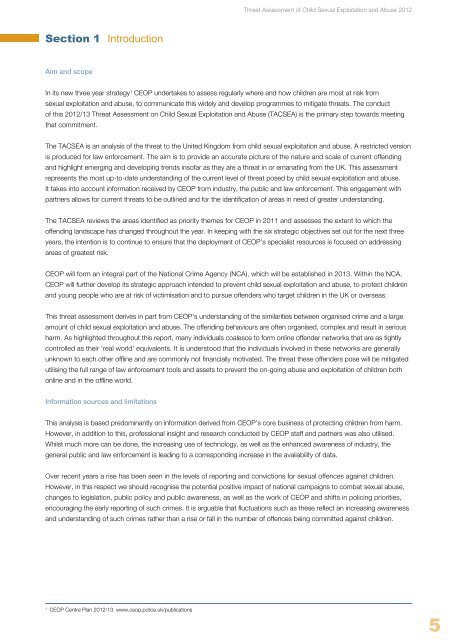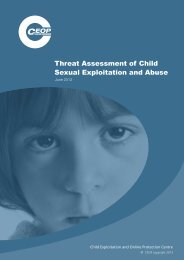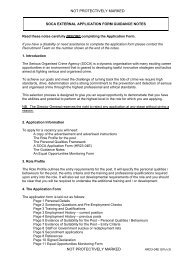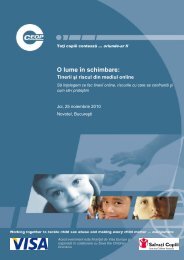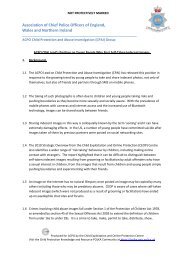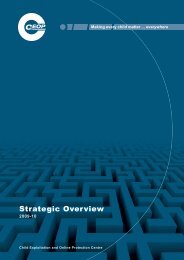Threat Assessment of Child Sexual Exploitation and Abuse - Ceop
Threat Assessment of Child Sexual Exploitation and Abuse - Ceop
Threat Assessment of Child Sexual Exploitation and Abuse - Ceop
Create successful ePaper yourself
Turn your PDF publications into a flip-book with our unique Google optimized e-Paper software.
Section 1 Introduction<br />
Aim <strong>and</strong> scope<br />
In its new three year strategy 1 CEOP undertakes to assess regularly where <strong>and</strong> how children are most at risk from<br />
sexual exploitation <strong>and</strong> abuse, to communicate this widely <strong>and</strong> develop programmes to mitigate threats. The conduct<br />
<strong>of</strong> this 2012/13 <strong>Threat</strong> <strong>Assessment</strong> on <strong>Child</strong> <strong>Sexual</strong> <strong>Exploitation</strong> <strong>and</strong> <strong>Abuse</strong> (TACSEA) is the primary step towards meeting<br />
that commitment.<br />
The TACSEA is an analysis <strong>of</strong> the threat to the United Kingdom from child sexual exploitation <strong>and</strong> abuse. A restricted version<br />
is produced for law enforcement. The aim is to provide an accurate picture <strong>of</strong> the nature <strong>and</strong> scale <strong>of</strong> current <strong>of</strong>fending<br />
<strong>and</strong> highlight emerging <strong>and</strong> developing trends ins<strong>of</strong>ar as they are a threat in or emanating from the UK. This assessment<br />
represents the most up-to-date underst<strong>and</strong>ing <strong>of</strong> the current level <strong>of</strong> threat posed by child sexual exploitation <strong>and</strong> abuse.<br />
It takes into account information received by CEOP from industry, the public <strong>and</strong> law enforcement. This engagement with<br />
partners allows for current threats to be outlined <strong>and</strong> for the identification <strong>of</strong> areas in need <strong>of</strong> greater underst<strong>and</strong>ing.<br />
The TACSEA reviews the areas identified as priority themes for CEOP in 2011 <strong>and</strong> assesses the extent to which the<br />
<strong>of</strong>fending l<strong>and</strong>scape has changed throughout the year. In keeping with the six strategic objectives set out for the next three<br />
years, the intention is to continue to ensure that the deployment <strong>of</strong> CEOP’s specialist resources is focused on addressing<br />
areas <strong>of</strong> greatest risk.<br />
CEOP will form an integral part <strong>of</strong> the National Crime Agency (NCA), which will be established in 2013. Within the NCA,<br />
CEOP will further develop its strategic approach intended to prevent child sexual exploitation <strong>and</strong> abuse, to protect children<br />
<strong>and</strong> young people who are at risk <strong>of</strong> victimisation <strong>and</strong> to pursue <strong>of</strong>fenders who target children in the UK or overseas.<br />
This threat assessment derives in part from CEOP’s underst<strong>and</strong>ing <strong>of</strong> the similarities between organised crime <strong>and</strong> a large<br />
amount <strong>of</strong> child sexual exploitation <strong>and</strong> abuse. The <strong>of</strong>fending behaviours are <strong>of</strong>ten organised, complex <strong>and</strong> result in serious<br />
harm. As highlighted throughout this report, many individuals coalesce to form online <strong>of</strong>fender networks that are as tightly<br />
controlled as their ‘real world’ equivalents. It is understood that the individuals involved in these networks are generally<br />
unknown to each other <strong>of</strong>fline <strong>and</strong> are commonly not financially motivated. The threat these <strong>of</strong>fenders pose will be mitigated<br />
utilising the full range <strong>of</strong> law enforcement tools <strong>and</strong> assets to prevent the on-going abuse <strong>and</strong> exploitation <strong>of</strong> children both<br />
online <strong>and</strong> in the <strong>of</strong>fline world.<br />
Information sources <strong>and</strong> limitations<br />
<strong>Threat</strong> <strong>Assessment</strong> <strong>of</strong> <strong>Child</strong> <strong>Sexual</strong> <strong>Exploitation</strong> <strong>and</strong> <strong>Abuse</strong> 2012<br />
This analysis is based predominantly on information derived from CEOP’s core business <strong>of</strong> protecting children from harm.<br />
However, in addition to this, pr<strong>of</strong>essional insight <strong>and</strong> research conducted by CEOP staff <strong>and</strong> partners was also utilised.<br />
Whilst much more can be done, the increasing use <strong>of</strong> technology, as well as the enhanced awareness <strong>of</strong> industry, the<br />
general public <strong>and</strong> law enforcement is leading to a corresponding increase in the availability <strong>of</strong> data.<br />
Over recent years a rise has been seen in the levels <strong>of</strong> reporting <strong>and</strong> convictions for sexual <strong>of</strong>fences against children.<br />
However, in this respect we should recognise the potential positive impact <strong>of</strong> national campaigns to combat sexual abuse,<br />
changes to legislation, public policy <strong>and</strong> public awareness, as well as the work <strong>of</strong> CEOP <strong>and</strong> shifts in policing priorities,<br />
encouraging the early reporting <strong>of</strong> such crimes. It is arguable that fluctuations such as these reflect an increasing awareness<br />
<strong>and</strong> underst<strong>and</strong>ing <strong>of</strong> such crimes rather than a rise or fall in the number <strong>of</strong> <strong>of</strong>fences being committed against children.<br />
1 CEOP Centre Plan 2012/13. www.ceop.police.uk/publications<br />
5


